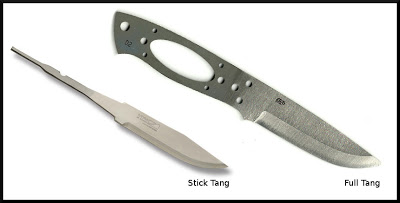

| Visitors Now: | |
| Total Visits: | |
| Total Stories: |

| Story Views | |
| Now: | |
| Last Hour: | |
| Last 24 Hours: | |
| Total: | |
What Makes a Good Survival Knife?
Like the internet message board favorite, “What is the best gun?”, asking what is the best survival knife is going to get you many different answers, though hopefully fewer than the inane gun version. Since you are here, reading on a blog devoted largely to wilderness skills, I’ll assume that the type of survival we are interested in is wilderness survival. One difficult that is encountered when trying to pick “the perfect knife” is that so many different types and sizes of tasks might be required of it. The same knife that you might clean an 8oz perch with is also the knife you expect to build you that cozy log cabin. You might want it to carve intricate trap triggers but also hold up to being stabbed into the side of a glacier as you ascend it. (What? You don’t think you’ll have to ascend glaciers to survive? You clearly need to go watch more TV.)
Like any other tool, knives are subject to competing demands. You either compromise and acquire a general knife that is mediocre in some, or possibly many, areas, or you carry a variety of specialized knives, designed to suit specific categories of tasks. This truth is old news and really is common sense. I’ll tell you right off the bat that I am not a single knife guy. I carry a small and large blade every time I am out in the woods and if I had to pick one or the other, I’d go with the smaller blade. But I’d rather not pick just one! So let’s focus in on what a realistic survival knife might look like – a single knife that may not be the best at either tiny or enormous tasks, but does a good job owning the middle ground.
Tang: The first consideration when choosing a hard-use knife is the design of the tang. The tang of the knife is the part of the metal that is hidden by the handle. You’ll see a few different tang designs, usually described as either full tang or stick tang. There is some confusion sometimes, likely accidental, about these terms but it’s actually super simple. A full tang knife has metal extending not only through the entire length of the handle, but also the width of the handle. A stick tang may extend the entire length of the handle, but does not span the width. Though stick tangs are my preference in terms of beauty and comfort, they would not be my choice in terms of straight durability.
Size: How large should a survival blade be? Well, this is the best example of competing needs. A small knife doesn’t baton well. A large knife doesn’t clean small fish well. What is the best compromise in terms of knife length? In my opinion, a 4″ blade is just about perfect on a survival knife. A 4″ blade means you can baton through roughly 3″ diameter wood, but leaves your control point close enough to you hands to allow precision use of the tip. I will say here, if you watch the shows like Les Stroud’s Beyond Survival or are lucky enough to see it in person, you’ll see native people in the jungle do everything, and I mean everything, with a machete. They have no problem doing even fine tasks with a giant 18″ blade. I guess this is a good place to plug the fact that the more you use any tool, the better you get with it and the more you can do with it.
Blade Profile: A drop point is the blade profile to go with. Aesthetically, it’s not my favorite, but in terms of use, dexterity, and toughness, it’s the best. Going along with the blade profile, having serrations on a survival knife is a debatable issue. Sharpening a knife without sharpening equipment can be tough, even counterproductive if done incorrectly. Serrations hold an edge longer and even when dull, they still offer the ability to “cut” by tearing. Personally, I don’t mind serrations, but only a short section of serrations at the base of the blade.
Those are the big 3 in terms of choosing a survival knife – tang, size, and blade profile. The rest of the features and options can suit your individual skills or preferences. A few other options to consider as you shop for your knife:
- Handle material: Micarta, wood, G10, paracord wrap
- Steel : D2, 1095, O1, 440, 1080, S30V
- Sheath: Kydex or leather
- Lanyard holes
- Thickness: 1/8″, 1/4″
- Custom or production?
A few that I would encourage you to check out in your search for the perfect blade
As mentioned above, when you settle on the knife that suits you, USE IT!
A blade with the finish still intact means you haven’t used it for
anything more demanding than opening letters. Practicing feather sticks, snare triggers, carving, even working in the kitchen with it all build up your comfort level in using, sharpening, and understanding your knife.
2013-04-15 14:51:22
Source: http://www.survivalogic.com/2013/04/what-makes-good-survival-knife.html
Source:



